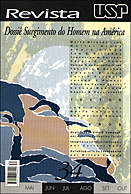ONDE ESTÃO OS REMANESCENTES ÓSSEOS HUMANOS DO FINAL DO PLEISTOCENO?
DOI:
https://doi.org/10.11606/issn.2316-9036.v0i34p22-33Resumo
ONDE ESTÃO OS REMANESCENTES ÓSSEOS HUMANOS DO FINAL DO PLEISTOCENO?Downloads
Referências
ALLEN, J.; O’CONNELL, J. (eds.). “Transitions: Pleistocene to Holocene in Australia and Papua New Guinea”, in Antiquity, 69, Special Edition, 1995.
ALLISON, M. “Chile’s Ancient Mummies”, in Natural History, 94, 1985, pp. 74-81.
BIANCHI, N. O.; BAILLIET, G.; BRAVI, C. M. “Peopling of the Americas as Inferred Through the Analysis of Mitochondrial DNA”, in Brazilian Journal of Genetics, 18, 1995, pp. 661-8.
BRYAN, A. “The Fluted Point Tradition in the Americas – One of Several Adaptations to Late Pleistocene American Environments”, in R. Bonnichsen; K. Turnmire (eds.), Clovis: Origins and Adaptations, Center for the Study of the First Americans, Corvallis, Oregon, 1991, pp. 15-33.
CANN, R.; STONEKING, M.; WILSON, A. C. “Mitochondrial DNA and Human Evolution”, in Nature, 325, 1987, pp. 31-6.
CHAUCHAT, C. “Early Hunter-gatherers on the Peruvian Coast”, in R. Keatinge (ed.), Peruvian Prehistory, Cambridge University Press, 1989, pp. 41-66.
COLLINS, M. “Rockshelters and the Early Archeological Record in the Americas”, in T. Dillehay; D. Meltzer (eds.), The First Americans: Search and Research, Florida, CRC Press, Boca Raton, 1991, pp. 157-82.
DILLEHAY, T. D.; MELTZER, D. (eds.). The First Americans: Search and Research, Florida, CRC Press, Boca Raton, 1991.
DILLEHAY, T. D.; ARDILA, G.; POLITIS, G.; BELTRÃO, M. C. “Earliest Hunters and Gatherers of South America”, in Journal of World Prehistory, 6, 1992, pp. 145-204.
GONZALEZ, R. “Excavations in Bolivia”, in Anthropological Papers of the American Museum of Natural History, 35, 1985, pp. 329-507.
LAHR, M. M. The Evolution of Modern Human Diversity: a Study of Cranial Variation. Cambridge University Press, 1996.
LYNCH, T. “Glacial-Age Man in South America? A Critical Review”, in American Antiquity, 55, 1990, pp. 12-36.
MELTZER, D. “Why Don’t We Know When the First People Came to North America”, in American Antiquity, 54, 1989, pp. 471-90.
MELTZER, D. “Monte Verde and the Pleistocene Peopling of the Americas”, in Science, 276, 1996, pp. 754-6.
NEVES, W. A.; PUCCIARELLI, H. M. “The Origin of the First South Americans: an Analisys Based on the Cranial Morphology of Early South American Human Remains”, in American Journal of Physical Anthropology, 81, 1990, p. 274.
NEVES, W. A.; PUCCIARELLI, H. M.; MEYER, D. “The Contribution of the Morphology of Early South- and NorthAmerican Skeletal Remains to the Understanding of the Peopling of the Americas”, in American Journal of Physical Anthropology, Supplement, 16, 1993, pp. 150-1.
QUILTER, J. Life and Death at Paloma: Society and Mortuary Practices in a Preceramic Peruvian Village. Iowa City, University of Iowa Press, 1989.
SALZANO, F. “DNA, Proteins and Human Diversity”, in Brazilian Journal of Genetics, 18, 1995, pp. 645-50.
SCHIAPPACASSE, V.; NIEMEYER, H. Descripción y Análisis Interpretativo de un Sitio Arcaico Temprano en la Quebrada de Camarones. Santiago, Publicación Ocasional, 41, Museo Nacional de Historia, 1985.
STANFORD, D. “Clovis Origins and Adaptations: an Introductory Perspective”, in R. Bonnichsen; K. Turnmire (eds.), Clovis: Origins and Adaptations, Oregon, Center for the Study of the First Americans, Corvallis, 1991, pp. 15-33.
STEELE, D. G.; POWELL, J. F. “Peopling of the Americas: Paleobiological Evidence”, in Human Biology, 64, 1992, pp. 303-36.
STOTHERT, K. “The Preceramic Las Vegas Culture of Coastal Ecuador”, in American Antiquity, 50, 1985, pp. 613-37.
TANKERSLEY, K. “A Close Look at the Big Picture: Early Paleoindian Lithic Procurement in the Midwestern United States”, in C. Ellis; J. Lothrop (eds.), Eastern Paleoindian Lithic Resource Use, 1989, pp. 259-92.
TAYLOR, R. E.; PAYEN, L. A.; PRIOR, C. A.; SLOTA JR., P. J.; GILLESPIE, R.; GOWLETT, J. A.; HEDGES, R. E.; HULL, A. J.; ZABEL, T. H.; DONAHUE, D. J.; BERGER, R. “Major Revisions in the Pleistocene Age Assignments for North American Human Skeletons by C-14 Accelerator Mass Spectrometry: None Older than 11,000 C-14 Years Ago”, in American Antiquity, 50, 1985, pp. 138-45.
TORRONI, A.; WALLACE, D. “mtDNA Haplogroups in Native Americans”, in American Journal of Human Genetics, 56, 1995, p. 1.234.
TRINKHAUS, E.; SHIPMAN, P. The Neanderthals: Changing the Image of Mankind., New York, Alfred Knopf, 1992.
TURNER II, C. G. “Dental Evidence for the Peopling of the Americas”, in R. Shutler (ed.), Early Man in the New World, Sage Publications, 1983, pp. 34-55.
WOLPOFF, M. “Multiregional Evolution: the Fossil Alternative to Eden”, in P. Mellars; C. Stringer (eds.), The Human Revolution, Scotland, Edinburgh University Press, 1984, pp. 62-108.
ZAGO, M.; MELO SANTOS, E.; CLEGG, J.; GUERREIRO, J.; MARTINSON, J.; NORWICH, J.; FIGUEIREDO, M. “a-Globin Gene Haplotypes in South American Indians”, in Human Biology, 67, 1995, pp. 535-42.
Downloads
Publicado
Edição
Seção
Licença
Copyright (c) 2023 Revista USP

Este trabalho está licenciado sob uma licença Creative Commons Attribution-NonCommercial-ShareAlike 4.0 International License.
|
Pertence à revista. Uma vez publicado o artigo, os direitos passam a ser da revista, sendo proibida a reprodução e a inclusão de trechos sem a permissão do editor. |


